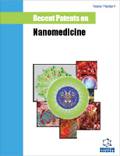Abstract
Wound dressing is radically shifting its direction from traditional and modern dressings to technologicallyadvanced nano dressings. Innovations in electrospinning have accelerated the evolutionary pace of wound dressing towards nano fibers. Non-woven nano fibers fabricated by electrospinning offer many versatile features for a wound dressing because of its high surface area-to-volume ratio. Functional properties of nano fibers are attributed to many parameters. The significance of nano fibers in wound healing are evident from the recent patents filed regarding the synthesis of polypeptide nanofiber gel, hemostatic wound dressings and dressings incorporating antibiotics, antiinflammatory drugs and growth factors. This review focus on the influence of biopolymer concentration, solvent, solution rheology and processing conditions used for electrospinning on architecture and function of nano fiber. Further discussion to explore the recent advancement in the use of state of the art work of nano fiber as a scaffold and drug delivery vehicle for wound healing, is also presented. Other issues pertaining to limitations of nano fibers, challenges in the clinical use of nano fibers for wound healing and its future prospects were summarized, as well.
Keywords: Biopolymers, electrospinning, nano fibers, scaffold and wound dressing.
Graphical Abstract
 17
17

